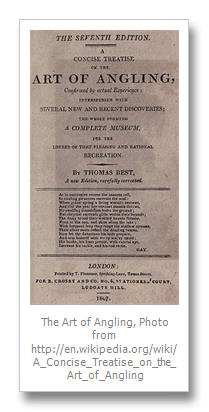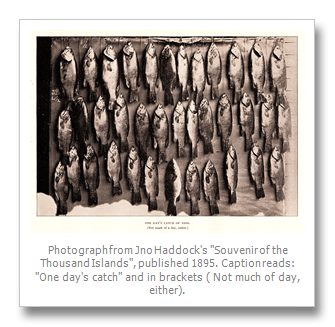Written by
Rex Ennis posted on January 13, 2011 22:25
The history of the Thousand Islands is littered with the tales of fishing and the big one that got away. Samuel Sondheim, grandfather of Oscar winner Stephen Sondheim was a frequent visitor to the New Frontenac Hotel; in fact he passed away at the hotel. His favorite pastime was fishing and the story of him and his four friends catching 400 bass in one day, an average of 80 bass each is astounding, but H. R. Clarke’s tales are extraordinary.

The Anglers’ Association of the St. Lawrence1 was founded to advance the sport of fishing and to protect the fish stock. Members included the famous and not so famous names on the river; Boldt, Skinner, Emery, Oliphant, Browning, and Clarke. Herbert R. Clarke was born in New York in 1828, married Mary Bailey, some years his junior, and settled into the dry goods business in Jersey City, New Jersey. Clarke was an ardent supporter of the Anglers’ Association, not only a member, but served as a First Vice President. The Association was the political action committee of its time.
In 1886, Clarke and W. W. Byington, Secretary of the Association, travelled to Washington, DC to meet with General Dumont, Supervising Inspector General of Steam Vessels in the Treasury Department, to lobby for a change in the skiff light law. Small row boats were required to have a fixed light and the Association was lobbing for a light which could be readily displayed in an instant. The Association had the support of President Cleveland, whose relatives had cottages on Grindstone Island.
Despite Clarke’s lobbing efforts Clarke's fame was in his fishing, for it was his first love. From Southside Island (a check of Ross D. Pollack’s comprehensive list of Islands, T I Life, May 2009, does not identify a Southside Island) his angling would be the stuff that magazines and books would report. In Holberton’s The Art of Angling, 1887, Clarke’s 1885 catch of a sturgeon is recounted on page 17; “Mr. Herbert R. Clark [sic], of Jersey City, killed during the summer of 1885, at Alexandria Bay, in the presence of a number of witnesses a Sturgeon weighting 78 pounds. He was using an eight-once split-bamboo fly-rod, a fine silk Black-Bass line, and a single-gut leader. The fight lasted an hour and five minutes, and he had to follow the fish over a mile before he was captured.” What Holberton fails to mention, it was finally shot with a repeating rifle. This item was covered in the Utica Daily Observer.

Clarke was methodical and kept a record of number and kind of fish he caught. The Syracuse Standard reported this incredible fish story on 20 July 1884 “Mr. Clarke always keeps a record of the number and kinds of fish he takes each day. During the month of June he is said to have caught 1,407 black bass, 900 of which, weighting less than a pound, were thrown back into the river, in accordance with a recent law passed by the Legislature. Before throwing them back he always clips the tail with a pair of scissors, to serve as a private mark should he happen to take the same fish another season.”
In 1884, Clarke was awarded a "First Prize" medal for black bass by the New York State Association for the Protection of Fish and Game. The Utica Morning Herald reported that Clarke caught “12 wall-eyed pike in one day” in front of Fine View in August 1900; it was said that Clarke caught more wall-eyes than any other fisherman that came to the islands.
When the Anglers’ Association mounted a campaign against illegal fishing with nets in the St. Lawrence, Clarke was a major enforcer. According to the Utica Morning News, 10 August 1885, “H. R. Clarke of Jersey City, with his assistants, has captured 30 of these nets.” The Watertown Daily Times, 1886 wrote, “His steam yacht goes daily to many parts of the river, and himself and his employees omit no opportunity to pull nets. He has permission from the Canadian authorities to remove nets from their water when they are illegal, and he has during the past year made many raids on their side of the river as well as our own.”
Clarke was with Tefft, Weller & Co., NY, a wholesale dry goods house. He was a director of the ill-fated City Bank of Jersey City, NJ, when it failed in 1885; also a director of the Fifth Ward Savings Bank of Jersey City, a director of the Edwin S. Piper Company of Brooklyn, also a dry goods house. As far a fish tales are told the Syracuse Standard observed; “Mr. Clarke’s veracity is unquestionable.”
By Rexford M. Ennis, Grindstone Island
© Copyright Rexford M. Ennis 2010, All Rights Reserved
Rex Ennis has written several articles for TI Life. He has also contributed to our History Page which can be found under the Tag: “The Place”. He recently published a biography of Charles G. Emery entitled: Toujours Jeune Always Young which was reviewed in TI Life, June 2010. We also just learned that Rex is hard at work this winter completing another book which will be a “definitive guide to the people that made the Glided Age in the Thousand Islands. It is called Saints, Sinners and Sailors of the Gilded Age. In addition, Rex has presented TI Life with a database he compiled listing all the guests who summered at the Frontenac Hotel on Round Island a century ago. This will be placed online in February.
1See Paul Malo’s Editorial “Who’s Minding the Store” published in May 2008 for a more complete description of the Angler’s Association and its importance to the region.